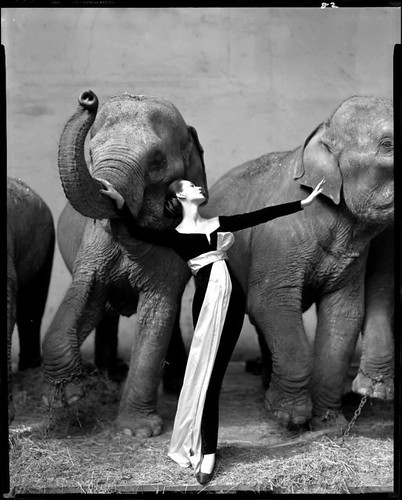valeriee* says:"Art is a lie that brings us nearer to the truth." Pablo PicassoDo you agree with this?? Why? So I answered with the following profundity |
scribble1 "Art is a con game that_________" scribble1 |
And when I went to Valeriee's photostream I discovered what I should have suspected but didn't. She was bright high school student with a paper to write and was looking around for ideas. So I commented with:
And my reply:
http://www.smithsonianmag.com/arts-culture/Fashion_Faux_Paw.html

My often given (and I suspect mostly ignored) advice I offer to young photographers is to buy a book on the history of photography. Any history, used, battered and cheap, as long as it is crammed full of pictures.
The idea is to use the pictures as a starting point for your own work. Given the zillions of images flooding the world it is highly unlikely that any of us will ever take a picture that even approaches truly original. In photography it is always theme and variation.
Even this iconic image wasn't truly original. According to the article I linked a Martin Munkacsi, who I never heard of, started the fashion trend that Avedon took up. So as soon as I finish this I'll google Munkacsi and see what he has worth imitating. Ain't the Internet wonderful?
Edit
I didn't remember Munkacsi's name. As soon as I pulled up a gallery of his images I recognized several. He's not well known but worth looking at.
And to semi repeat myself Ain't copy and paste wonderful. A few clicks and this post is almost written.
To push this blog in a new directions here is an example of what I was talking about--using what I found in a photo book as the starting point of a photo shoot.
I found this in 100 Photographs by John Szarkowski, a long time curator of the photography department of the Museum of Modern Art. It is Miss Grace by Clarence White, one of the best photographers in the photo-secession movement of the early 20th century
At the time Julie, my model from next door, was a freshman in high school. I asked her if she happened to own a white dress-- a garment found in many wardrobes back in Miss Grace's era but sparse in this era of jeans and t-shirts.
Knowing how Julie usually dressed I was expecting a "No" but I was wrong. Pushed in the back of her closet was the dress her mother had picked out for her 8th grade graduation. So we set up a photo shoot for Saturday afternoon.
Some shots we came up with:
This image almost made it into a juried show at the Overture Center. But since the other three images I submitted did hang on the wall, I could hardly complain. Julie was disappointed but the framed photo now is on the picture wall of her parent's house
Julie has an independent streak. I'd gone to the trouble of finding a book on chess and setting up the board to show the middle of a real game. She didn't like the arrangement and moved the pieces the way she liked them. Which would cause a chess player to look in bemusement--like two black bishops on the same color. I kept shooting away
In the middle of the shoot Julie told me she was tired of wearing the white dress and had a better costume in mind. She raided her mother's closet and came out wearing this. So I did end up with my "Miss Grace" image. Sort of anyway.





Before I uncovered your plot I gave you a story. Since student papers are often long on researched generalities and short on stories that provide a scaffolding to build an A paper around, you may find my story useful. In my mind, the story also asks more questions than it answers. So I'm interested in what you find or don't find in it.
Because I have my own fiendish plot. I have a blog. So far it has been devoted to the more technical aspects of cameras and photography. But I feel the urge to move towards different topics and questions.
Like "In this digital age when anything can be copied why do some rich folks still spend astronomical amounts of money ($1,200,000 recently) on a single print?